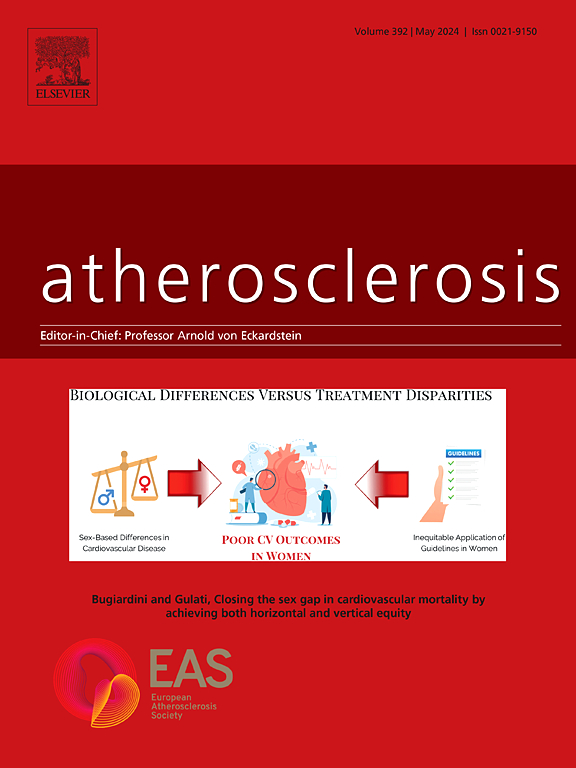Basal and exercise-induced expression of NLRP3 inflammasome-related components is increased in patients with chronic coronary syndrome
IF 5.7
2区 医学
Q1 CARDIAC & CARDIOVASCULAR SYSTEMS
引用次数: 0
Abstract
Background and aims
NLRP3 inflammasome is considered a critical actor in the inflammatory process of coronary artery disease. Increased expression of NLRP3 inflammasome components has been reported in patients with acute coronary syndrome, but whether this persists beyond the acute phase is less known. We performed a prospective study to investigate whether basal and/or exercise-induced NLRP3 inflammasome components were elevated in patients with chronic coronary syndrome (CCS).
Methods
Patients (n = 81) underwent exercise stress tests twice: 3–4 weeks and 3–6 months after a major coronary event, whereas controls (n = 30) performed it once. Concentrations of interleukin(IL)-18, IL-1Ra and IL-6 were measured before and 30 min after exercise. Genes related to NLRP3 inflammasome and NFκB signaling pathways were measured in blood mononuclear cells before and after exercise. On the first visit, patients were prescribed an exercise-based cardiac rehabilitation program. Physical activity levels were reported on both visits.
Results
Patients were clinically stable and exhibited increased exercise capacity as well as increased self-reported physical activity between visits. Basal plasma levels of IL-18, as well as exercise-induced levels of IL-18 and IL-1Ra, were higher in patients compared with controls on both visits. Also, basal gene expression of NLRP3 was higher in patients, as were several NFκB-related genes. After exercise, gene expression related to NLRP3 inflammasome activation, in particular P2RX7, was higher in patients on both visits.
Conclusions
Up to 6 months after a coronary event, patients exhibited an increase in NLRP3 inflammasome-related components that was even more pronounced after acute exercise, compared with controls. The results indicate that a primed NLRP3 inflammasome system is maintained despite clinical stability and best available therapy, highlighting the need to further combat inflammation in patients with CCS.

慢性冠状动脉综合征患者NLRP3炎性小体相关成分的基础表达和运动诱导表达增加
背景和目的snlrp3炎性小体被认为是冠状动脉疾病炎症过程中的关键参与者。在急性冠状动脉综合征患者中,NLRP3炎性小体成分的表达增加已被报道,但这种情况是否持续到急性期后尚不清楚。我们进行了一项前瞻性研究,以调查慢性冠状动脉综合征(CCS)患者的基础和/或运动诱导的NLRP3炎性体成分是否升高。方法患者(81例)在发生冠心病事件后3-4周和3-6个月分别进行两次运动应激试验,对照组(30例)进行一次运动应激试验。在运动前和运动后30min测定白细胞介素(IL)-18、IL- 1ra、IL-6的浓度。在运动前后测定血单个核细胞NLRP3炎性体和NFκB信号通路相关基因。在第一次就诊时,医生给患者开了一个基于运动的心脏康复计划。两次访问都报告了身体活动水平。结果患者临床稳定,在两次就诊之间表现出增强的运动能力和增加的自我报告的身体活动。患者的基础血浆IL-18水平以及运动诱导的IL-18和IL-1Ra水平均高于对照组。此外,NLRP3的基础基因表达在患者中较高,一些nfκ b相关基因也是如此。运动后,与NLRP3炎性体激活相关的基因表达,特别是P2RX7,在两次就诊的患者中都较高。结论:冠状动脉事件发生后6个月,患者表现出NLRP3炎性小体相关成分的增加,与对照组相比,急性运动后的NLRP3炎性小体相关成分的增加更为明显。结果表明,尽管临床稳定性和最佳可用治疗,但仍维持了启动的NLRP3炎性体系统,这突出了进一步对抗CCS患者炎症的必要性。
本文章由计算机程序翻译,如有差异,请以英文原文为准。
求助全文
约1分钟内获得全文
求助全文
来源期刊

Atherosclerosis
医学-外周血管病
CiteScore
9.80
自引率
3.80%
发文量
1269
审稿时长
36 days
期刊介绍:
Atherosclerosis has an open access mirror journal Atherosclerosis: X, sharing the same aims and scope, editorial team, submission system and rigorous peer review.
Atherosclerosis brings together, from all sources, papers concerned with investigation on atherosclerosis, its risk factors and clinical manifestations. Atherosclerosis covers basic and translational, clinical and population research approaches to arterial and vascular biology and disease, as well as their risk factors including: disturbances of lipid and lipoprotein metabolism, diabetes and hypertension, thrombosis, and inflammation. The Editors are interested in original or review papers dealing with the pathogenesis, environmental, genetic and epigenetic basis, diagnosis or treatment of atherosclerosis and related diseases as well as their risk factors.
 求助内容:
求助内容: 应助结果提醒方式:
应助结果提醒方式:


